The current conditions are good for crops and favourable for mice. Farmers need to act now to minimise damage to crops, equipment and homes.
- Be alert for an increase in mouse numbers.
- Measure mouse activity by using the downloadable chew cards or counting burrows.
- Be prepared to bait at sowing if mice are active in your paddocks.
- Follow the label when baiting. This reduces the risk of bait aversion and harm to other animals.
- Reduce alternative food sources for mice that will compete with your bait.
- Bait with neighbours in a co-ordinated strategy for area-wide management and highest impact.
- Monitor the success of baiting as your crop matures.
- Report and map what you see on the MouseAlert app or website.
- Wear gloves and protective clothing when handling baits, dead mice and items contaminated by mice.
- Wash your hands after contact with baits, mice or contaminated items.
Harvest time video
CSIRO Research Officer, Steve Henry provides advice to growers for the harvest period.
Download
Download this videoInspecting and monitoring your paddocks - preparation is key
Inspect paddocks regularly for mice. The best way is to get out of your vehicle and walk through the paddock. Look for signs of active burrows and/or crop damage. In cereals this may be chewing at the node or stem. In canola and legume crops, inspect flowers and pods for damage. Look in multiple locations.
The Grains Research and Development Corporation (GRDC) has produced mouse chew cards which are a simple yet effective tool to measure activity in the paddock.
Download the chew cards from the GRDC website.
Don’t rely solely on one method of monitoring. In spring, high biomass makes finding burrows difficult. In stubbles where there is lots of residual food, chew cards become less reliable and burrow counts become a better indicator of mouse activity.
Bait for success
It is important that mice find the bait and eat this before they find alternative food. The first dose needs to be fatal, otherwise mice that have ingested bait and survived, won’t eat another bait. For the best chance of getting on top of mice, bait with 50 g/kg zinc phosphide coated baits.
Mouse numbers rise quicky so be prepared to start baiting when you see the first signs of mouse damage. Baiting early before there is a lot of other food in the system provides mice with the best opportunity to find a lethal dose. Bait large areas (together with your neighbours) for widespread impact and to reduce reinvasion.
Always continue monitoring to ensure your baiting is successful.
While bait is effective in wet conditions it is better to bait when dry weather is forecast. Aim for at least three to four dry days. Do not bait ahead of a significant rain event.
Around houses, structures and stored produce, use the appropriate bait. There is a large range of anticoagulant bait products available through rural suppliers, hardware stores and supermarkets. These are usually sold as sachets, wax blocks and bait stations and must be used in accordance with the label.
In your area
State and territory governments have primary responsibility for managing pest animals. Visit the relevant state or territory government website for advice on local support measures:
- NSW DPI – Mouse management
- Agriculture Victoria
- Tasmania
- South Australia
- Western Australia
- Northern Territory
- Queensland
Additional resources
GRDC

The Grains Research and Development Corporation (GRDC) has useful information about mouse monitoring and management for grain growers.
GRDC

Sowing often occurs in autumn and this is a key time for monitoring mice infestation and for baiting if required.This video provides practical information for farmers. Note: Click on ‘skip ads’ to progress straight to the video.
MouseAlert
MouseAlert is a free resource that grain producers and farmers can use to record and report the prevalence of mice before they become a major issue.
CSIRO

The Commonwealth Scientific and Industrial Research Organisation (CSIRO) is working with GRDC to enhance understanding of mouse ecology, biology, and management.
Get to know the research CSIRO is doing to enhance mouse control
APVMA

The Australian Pesticides and Veterinary Medicines Authority (APVMA) is responsible for assessing, registering and approving agricultural and veterinary chemical products in Australia.




